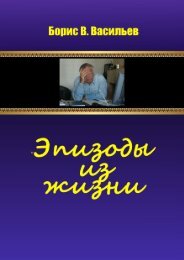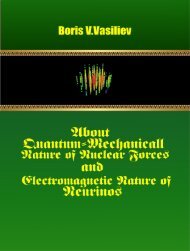VbvAstE-001
Book Boris V. Vasiliev Astrophysics
Book Boris V. Vasiliev
Astrophysics
You also want an ePaper? Increase the reach of your titles
YUMPU automatically turns print PDFs into web optimized ePapers that Google loves.
Chapter 10<br />
A mechanism of<br />
stabilization for<br />
neutron-excess nuclei in<br />
plasma<br />
10.1 Neutron-excess nuclei and the neutronization<br />
The form of the star mass spectrum (Fig.5.1) indicates that plasma of many stars consists<br />
of neutron-excess nuclei with the ratio A/Z = 3, 4, 5 and so on. These nuclei are<br />
subjects of a decay under the ”terrestrial” conditions. Hydrogen isotopes 4 1H, 5 1H, 6 1H<br />
have short time of life and emit electrons with energy more than 20 Mev. The decay<br />
of helium isotopes 6 2He, 8 2He, 10<br />
2 He have the times of life, which can reach tenth part<br />
of the seconds.<br />
Stars have the time of life about billions years and the lines of their spectrum of<br />
masses are not smoothed. Thus we should suppose that there is some mechanism of<br />
stabilization of neutron-excess nuclei inside stars. This mechanism is well known - it is<br />
neutronization [12]§106. It is accepted to think that this mechanism is characteristic<br />
for dwarfs with density of particles about 10 30 per cm 3 and pressure of relativistic<br />
electron gas<br />
P ≈ c · ne 4/3 ≈ 10 23 dyne/cm 2 . (10.1)<br />
The possibility of realization of neutronization in dense plasma is considered below<br />
in detail. At thus, we must try to find an explanation to characteristic features of the<br />
75













